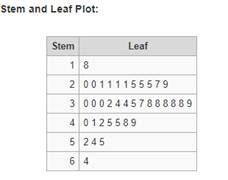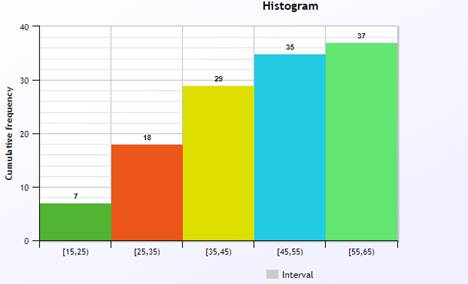
a)
To graph: A stem and leaf plot of given data is to be drawn.
a)
Answer to Problem 2PS
Median
Range
Explanation of Solution
Given information: Data of ages of adult male passengers on the Mayflower at the time of its departure
Graph:

Key:
Interpretation:
Leaves represent the unit digits of the numbers and stem represent the tens digits.
b)
The median and the range of the ages are to be calculated.
b)
Answer to Problem 2PS
Median
Range
Explanation of Solution
Given: Data of ages of adult male passengers on the Mayflower at the time of its departure
Concept Used: Formula of median:
If the number of observations (n) is odd, then median is
Range
Calculation: For median:
Firstly, arrange the data in increasing order
Here, number of observations is odd
Then, Median
So, the 16th observation is
Range
Range
Conclusion:
Median
Range
b)
The median and the range of the ages are to be calculated.
b)
Answer to Problem 2PS
Median
Range
Explanation of Solution
Given: Data of ages of adult male passengers on the Mayflower at the time of its departure
Concept Used: Formula of median:
If the number of observations (n) is odd, then median is
Range
Calculation: For median:
Firstly, arrange the data in increasing order
Here, number of observations is odd
Then, Median
So, the 16th observation is
Range
Range
Conclusion:
Median
Range
c)
To find the probability of age of Thomas English passenger that having age of
c)
Answer to Problem 2PS
Probability is
Explanation of Solution
Given: Data of ages of adult male passengers on the Mayflower at the time of its departure
Concept Used: Probability P(A)
Where, P (A) is the Probability of an event
Calculation: Probability P (A)
P (A)
Conclusion: Probability is
d)
To graph: A cumulative frequency distribution and cumulative frequency histogram for the data is to be drawn.
d)
Explanation of Solution
Given information: Data of ages of adult male passengers on the Mayflower at the time of its departure
Graph: Cumulative frequency distribution
| Interval | Frequency | Cumulative Frequency |
| [15,25) | 7 | 7 |
| [25,35) | 11 | 7+11=18 |
| [35,45) | 11 | 7+11+11=29 |
| [45,55) | 6 | 7+11+11+6=35 |
| [55,65) | 2 | 7+11+11+6+2=37 |
Cumulative frequency histogram:

Interpretation: Cumulative frequency is the running total of frequencies.
Chapter 13 Solutions
EBK PRECALCULUS W/LIMITS
 Calculus: Early TranscendentalsCalculusISBN:9781285741550Author:James StewartPublisher:Cengage Learning
Calculus: Early TranscendentalsCalculusISBN:9781285741550Author:James StewartPublisher:Cengage Learning Thomas' Calculus (14th Edition)CalculusISBN:9780134438986Author:Joel R. Hass, Christopher E. Heil, Maurice D. WeirPublisher:PEARSON
Thomas' Calculus (14th Edition)CalculusISBN:9780134438986Author:Joel R. Hass, Christopher E. Heil, Maurice D. WeirPublisher:PEARSON Calculus: Early Transcendentals (3rd Edition)CalculusISBN:9780134763644Author:William L. Briggs, Lyle Cochran, Bernard Gillett, Eric SchulzPublisher:PEARSON
Calculus: Early Transcendentals (3rd Edition)CalculusISBN:9780134763644Author:William L. Briggs, Lyle Cochran, Bernard Gillett, Eric SchulzPublisher:PEARSON Calculus: Early TranscendentalsCalculusISBN:9781319050740Author:Jon Rogawski, Colin Adams, Robert FranzosaPublisher:W. H. Freeman
Calculus: Early TranscendentalsCalculusISBN:9781319050740Author:Jon Rogawski, Colin Adams, Robert FranzosaPublisher:W. H. Freeman
 Calculus: Early Transcendental FunctionsCalculusISBN:9781337552516Author:Ron Larson, Bruce H. EdwardsPublisher:Cengage Learning
Calculus: Early Transcendental FunctionsCalculusISBN:9781337552516Author:Ron Larson, Bruce H. EdwardsPublisher:Cengage Learning





